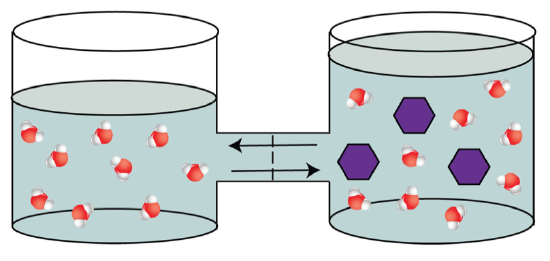The Movement of Salt and Water Will Continue Until
Diffusion and Osmosis
- Page ID
- 23851
1. Description of Diffusion and Osmosis
A water solution that contains nutrients, wastes, gases, salts and other substances surrounds cells. This is theexternal environment of a cell. The cell's outer surface of the plasma membrane is in contact with this external environment, while the inner surface is in contact with the cytoplasm. Thus, the plasma membrane controls what enters and leaves the cell.
The membrane permits the passage of some materials, but not all. The cell membrane is said to beselectively permeable. Small molecules, for example, may pass through the membrane. If no energy is required for substances to pass through the membrane, the process is calledpassive transport. We will discuss two examples of passive transport in this tutorial:diffusion andosmosis.
Diffusion
Although you may not know what diffusion is, you have experienced the process. Can you remember walking into the front door of your home and smelling a pleasant aroma coming from the kitchen? It was diffusion of molecules from the kitchen to the front door of the house that allowed you to detect the odors.
Diffusion is defined as the net movement of molecules from an area of greater concentration to an area of lesser concentration.
The molecules in a gas, a liquid or a solid are in constant motion due to theirkinetic energy. Molecules are in constant movement and collide with each other. These collisions cause the molecules to move in random directions. Over time, however, more molecules will be propelled into the less concentrated area. Thus, the net movement of molecules is always from more tightly packed areas to less tightly packed areas. Many things can diffuse. Odors diffuse through the air, salt diffuses through water and nutrients diffuse from the blood to the body tissues.
This spread of particles through random motion from an area of high concentration to an area of lower concentration is known as diffusion. This unequal distribution of molecules is called aconcentration gradient. Once the molecules become uniformly distributed,dynamic equilibriumexists. The equilibrium is said to be dynamic because molecules continue to move, but despite this change, there is no net change in concentration over time. Both living and nonliving systems experience the process of diffusion. In living systems, diffusion is responsible for the movement of a large number of substances, such as gases and small uncharged molecules, into and out of cells.

Figure \(\PageIndex{1}\). (CC BY-NC-SA)
Osmosis
Osmosis is a specific type of diffusion; it is the passage of water from a region of high water concentration through a semi-permeable membrane to a region of low water concentration.
Semi-permeable membranes are very thin layers of material which allow some things to pass through them, but prevent other things from passing through. Cell membranes are an example of semi-permeable membranes. Cell membranes allow small molecules such as oxygen, water carbon dioxide and glucose to pass through, but do not allow larger molecules like sucrose, proteins and starch to enter the cell directly.

Figure \(\PageIndex{2}\). (CC BY-NC-SA)
Example: If there was a semi-permeable membrane with more water molecules on one side as there were on the other, water molecules would flow from the side with a high concentration of water to the side with the lower concentration of water. This would continue until the concentration of water on both sides of the membrane were equal (dynamic equilibrium is established).

Figure \(\PageIndex{3}\). (CC BY-NC-SA)
Osmotic Pressure
Adding sugars to water will result in a decrease in the water concentration because the sugar molecules displace the water molecules.

Figure \(\PageIndex{4}\). osmotic pressure (CC BY-NC-SA;LadyOfHats)
If the two containers are connected, but separated by a semi-permeable membrane, water molecules would flow from the area of high water concentration (the solution that does not contain any sugar) to the area of lower water concentration (the solution that contains sugar).

Figure \(\PageIndex{5}\). osmotic pressure (CC BY-NC-SA;LadyOfHats)
This movement of water would continue until the water concentration on both sides of the membrane is equal, and will result in a change in volume of the two sides. The side that contains sugar will end up with a larger volume.

Figure \(\PageIndex{6}\). osmotic pressure (CC BY-NC-SA;LadyOfHats)
Water solutions are very important in biology. When water is mixed with other molecules this mixture is called asolution. Water is thesolvent and the dissolved substance is thesolute. A solution is characterized by the solute. For example, water and sugar would be characterized as a sugar solution.
The classic example used to demonstrate osmosis and osmotic pressure is to immerse red blood cells into sugar solutions of various concentrations. There are three possible relationships that cells can encounter when placed into a sugar solution.
1. The concentration of solute in the solution can beequal to the concentration of solute in cells. In this situation the cell is in anisotonic solution (iso = equal or the same as normal). A red blood cell will retain its normal shape in this environment as the amount of water entering the cell is the same as the amount leaving the cell.
2. The concentration of solute in the solution can begreater than the concentration of solute in the cells. This cell is described as being in ahypertonic solution (hyper = greater than normal). In this situation, a red blood will appear to shrink as the water flows out of the cell and into the surrounding environment.
3. The concentration of solute in the solution can beless than the concentration of solute in the cells. This cell is in ahypotonic solution (hypo = less than normal). A red blood cell in this environment will become visibly swollen and potentially rupture as water rushes into the cell.

Figure \(\PageIndex{4}\). (CC BY-NC-SA)

Figure \(\PageIndex{4}\). (CC BY-NC-SA)
Source: https://bio.libretexts.org/Learning_Objects/Worksheets/Biology_Tutorials/Diffusion_and_Osmosis#:~:text=This%20movement%20of%20water%20would,volume%20of%20the%20two%20sides.
0 Response to "The Movement of Salt and Water Will Continue Until"
Post a Comment